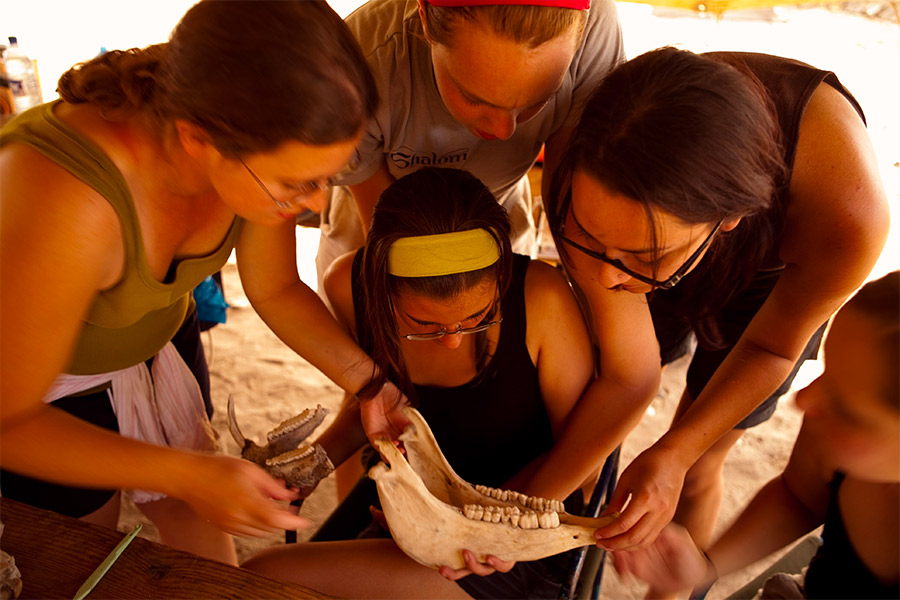- The study of zooarchaeology involves aspects of paleontology and zoology in combination with anthropological and evolutionary theory to better understand how ancient humans interacted with the other animals they lived among.
- Animal species information also helps researchers better understand ancient environments and how they have changed.
Highlights
Animal remains are some of the most abundant material recovered in prehistoric archaeological excavations and surveys. The study of animal remains with the aim of addressing archaeological questions is referred to as zooarchaeology (often called archaeozoology in Europe). This research involves aspects of paleontology and zoology in combination with anthropological and evolutionary theory to better understand how ancient humans interacted with the other animals they lived among.
Clues from what remains
Zooarchaeologists address a wide range of questions across time and space, such as when our ancestors began eating meat, whether Neandertals were hunters or scavengers, where and when animal domestication took place, and the foraging behaviors of hunter gatherers.
Zooarchaeologists collect a lot of data from animal remains. The first thing most zooarchaeologists do is try to identify which species are represented and what types of bones and teeth are present in an archaeological collection. This tells zooarchaeologists which types of animals were important to the diet of the humans or hominins they are studying.

Students in the field in Hadar, Ethiopia, examining the jaw of an animal skeleton.
Image credit Benjamin Reed
The frequency of different bones and teeth present in a collection can also be informative. For example, this data has been used in the debate about whether Neandertals were hunters or scavengers. It has been argued that hunters would have first access to the carcass they killed and therefore would transport the meatiest bones, such as the upper limb bones of antelopes, back to their homes. Scavengers, however, would only have access to the parts of the carcass that were left behind by other predators and would only get less nutritious parts, such as antelope feet. Animals remains associated with Neandertals that are dominated by the meaty upper limb bones are good indications that they were adept hunters.
Species information also helps researchers better understand ancient environments and how they have changed. For example, zooarchaeologists often look at whether the animals they have identified were adapted for wet or dry environments, and this can help reconstruct the conditions our ancestors evolved in. A collection dominated with species adapted for arid environments might indicate that that location was receiving less rainfall when the animal remains were deposited. Species have also been used to determine the relative date of a site, especially when extinct animals are present. In the past, extinct African pig species have helped determine the relative ages and correlation of different deposits containing fossil hominins.

This wildebeest fossil skull (left) was excavated at the Ledi-Geraru research site in Ethiopia. Modern wildebeests (right).
Image credit Joshua Robinson (left), Donald Johanson (right)
Zooarchaeologists sometimes determine the age at death of the animals in an archaeological collection. This can help zooarchaeologists better understand the hunting strategy of prehistoric people. Were humans targeting certain age groups, such as weaker individuals (the young and old) or individuals in their prime, which would confer the most meat? Some bones have signs indicting which sex the animal was, and zooarchaeologists can use these to determine if either males or females dominate the collection. The age structure and the sex ratios represented in a collection of animal remains has been useful for researchers interested in domestication. Pastoralists often cull young males to eat while allowing females to grow old and have lots of offspring. Goat remains from the Zagros Mountains, Iran, which show a shift around 10,000 years ago to dominance of young males and fewer older males, are evidence of the initial domestication of goats.
Cutmarks and early stone tool use
The surface of bones also contains information about what happened to the animals after their death. Zooarchaeologists often inspect each bone to identify evidence of butchery, such as cut marks made when detaching meat and percussion marks made when bashing open limb bones to access bone marrow. The earliest evidence of butchery marks on bones were discovered in Dikika, Ethiopia, and are dated to around 3.4 million years ago.

3.4-million-year-old animal bones that show marks consistent with stone tool cutmarks. (left) Two parallel marks, consistent with stone-tool cutmarks, on a 3.4-million-year-old bone, suggest that hominins may have been butchering animals before the evolution of the first Homo species. (right)
Image credit Dikika Research Project
This is the earliest zooarchaeological data yet discovered and marks the earliest evidence of meat eating in the hominin lineage. Tooth marks created by other predators are also important observations. This tells the zooarchaeologists about how the animal remains were accumulated—were the bones brought to the site by humans or by another carnivore? Other modifications to bones, such as weathering from exposure to the elements or rounding from tumbling down a river, can also speak to what processes affected the bones after the animal’s death. This helps archaeologists better understand how a site formed and calibrate the inferences they make to the quality of the data.
In paleoanthropology, animal remains have been one of the main sources of evidence for hominin behavior during our evolution. This data helps us to identify what prey species were important parts of the hominin diet and how this changed and expanded as we evolved more complex hunting adaptations. Animal remains can show archaeologists important aspects of past diet, behavior, and environmental conditions important for our understanding of human origins.
Written by Patrick Fahey